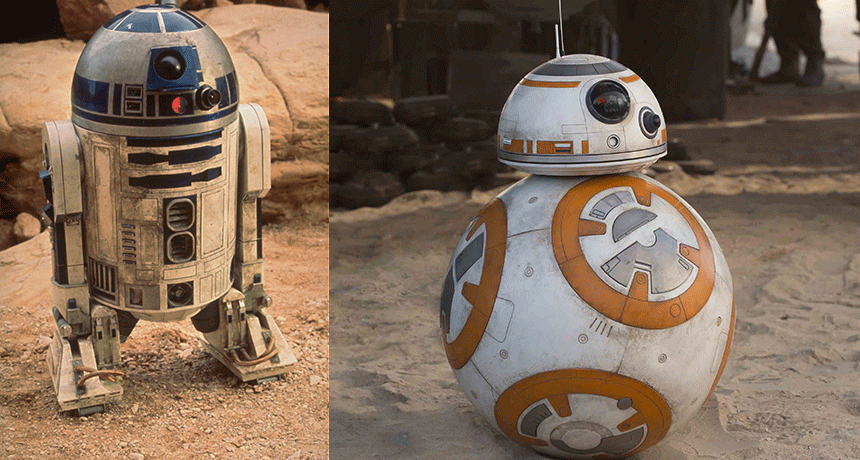Star Wars‘ cutest droids would get stuck on the beach
The wheels on a droid go round and round, until that droid rolls into sand

R2D2 (left) and BB-8 (right) appear to roll right across desert sand. But in reality they’d be left spinning their wheels.
© Lucasfilm Ltd. & TM. All Rights Reserved
R2D2 and BB-8 never seem to let anything hold them back, even when faced with vast, terrifying desert planets. R2D2 trundles cheerfully across the sands of Tatooine. BB-8 takes his own sandy trek on Jakku. Sadly, such scenarios aren’t realistic. Not because Star Wars is fiction (though it is). It’s because a droid with wheels has no place on a desert planet.
“Wheels don’t work well in sand, period,” says Robin Murphy. She studies robotics at Texas A&M University in College Station. Wheels, she notes, “dig in. The traction is just not there.” Using them in a setting on sand, she says, is just “wrong on so many levels.” Murphy published an article on the pros and cons of Star Wars droids February 21 in the journal Science Robotics.
It’s easy to think that the wheels of R2D2 or the ball of BB-8 would just slip over the sand. But slipping is why they would be in trouble. It has to do with the way a wheel rolls, explains Daniel Goldman. He studies biophysics — the physical forces related to living things — at the Georgia Institute of Technology in Atlanta.
Sandy surfaces
A wheel (or a BB unit) moves forward because there is no slipping between the wheel and the ground. “If an ant was riding on a wheel, it would go around, contact the ground and come up at the same point,” notes Goldman. This is because there is friction — resistance that the wheel encounters as it comes in contact with the ground.
That works pretty well inside the Millennium Falcon, with its solid metal floors. But sand is different. It’s not a solid surface but a compilation of tiny particles of rock. Those small pieces slip and move against one another. If BB-8 attempted to roll across a dune, the sand would slip around the little droid. The robot would soon dig itself into a hole. And as the little ball kept spinning, the sand would continue to slip. BB-8 would be unable to get enough friction under itself to climb out.
Goldman knows just how badly this turns out. “We tried it, when [Star Wars: Episode VII The Force Awakens] came out,” he says. Goldman and his colleagues placed a model of BB-8 on a bed of sand. “It’s terrible,” he explains. “It makes a little pit it can’t climb out of.”
R2D2 wouldn’t be much more successful, notes Murphy. The older droid (which made its first appearance in 1977’s Star Wars: Episode IV A New Hope) has sets of wheels on its “feet” that would get just as stuck.
When dealing with slippery substances like sand, Murphy explains, it’s best to have lots of surface area in contact with the surface. “When you see things going across the desert, they use the properties of the sand like sidewinders,” she notes. Sidewinders are a type of snake. They don’t press into the sand as they move. Instead, they flatten their bodies, which helps them keep contact with the sand.
A sidewinder-like robot might be one option for a desert droid. Another might be a droid that uses wide, flat treads to move, like a tank. Those treads spread out the tank’s weight and prevent the vehicle from sinking in as it moves.
Murphy and Goldman have mused about droids because they are developing robots that can handle any terrain. Such robots would be useful for tasks ranging from search and rescue after a disaster to exploring distant worlds in space. So, while BB-8 and R2D2 belong in a galaxy long ago and far away, the lessons they provide could be pretty useful to us Earthlings here and now.
Technically Fiction is a blog that finds the science in the realm of the fantastic. Have a comment or a suggestion for a future post? Send an email to sns@sciencenews.org.







